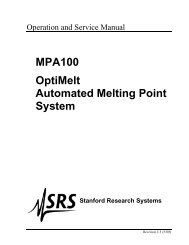Quartz Crystal Microbalance Theory and Calibration - Stanford ...
Quartz Crystal Microbalance Theory and Calibration - Stanford ...
Quartz Crystal Microbalance Theory and Calibration - Stanford ...
Create successful ePaper yourself
Turn your PDF publications into a flip-book with our unique Google optimized e-Paper software.
www.thinkSRS.com<br />
Figure 9. Cyclic voltammogram <strong>and</strong> massogram data for Cu deposition on a Au<br />
electrode. The frequency –potential diagram shows a frequency decrease in<br />
perfect sync with the deposition of Cu metal on the crystal’s surface.<br />
<strong>Calibration</strong><br />
It has been amply demonstrated in the literature that when experiments involve<br />
only relative frequency shifts which are measured in a fixed solution, the offset<br />
caused by the viscous loading of the liquid, has negligible effect on the accuracy<br />
of the Sauerbrey equation for the determination of small mass changes in rigid<br />
deposits 29 . Quantitative interpretation of the EQCM data in those cases is based<br />
on the combination of the Sauerbrey equation (equation 1) <strong>and</strong> Faraday’s law.<br />
The former relates change in frequency to change in mass for thin, rigid<br />
deposits, whereas the latter relates charge passed in an electrochemical<br />
experiment to the number of moles of material electrolyzed. Therefore, frequency<br />
changes can be related to the total charge passed.<br />
An example would be the electrodeposition of Ag on a Pt electrode QCM crystal.<br />
The charge, Q, is an integral measure of the total number of electrons delivered<br />
at the interface during the reduction process. To the extent, that each electron<br />
supplied results in the deposition of one atom of Ag, there should be a linear<br />
relationship between Q <strong>and</strong> ∆f as is given by equation 8:<br />
∆f = 10 6 . M w . C f . Q / (n . F . A) (equation 8)<br />
where,<br />
<strong>Stanford</strong> Research Systems (408)744-9040

















